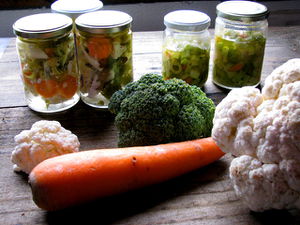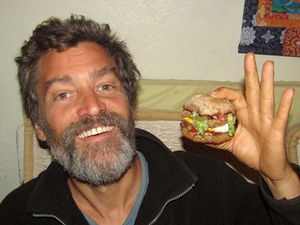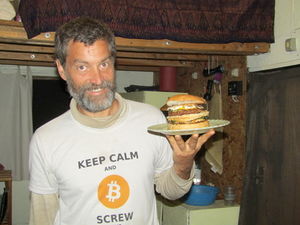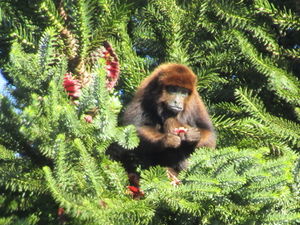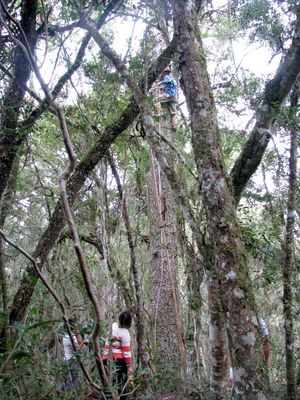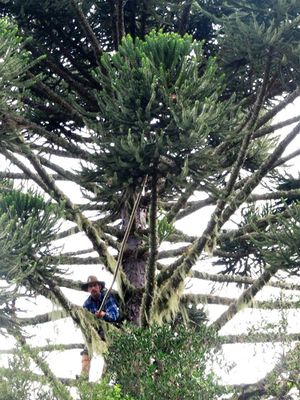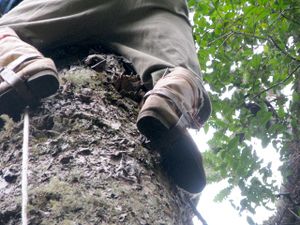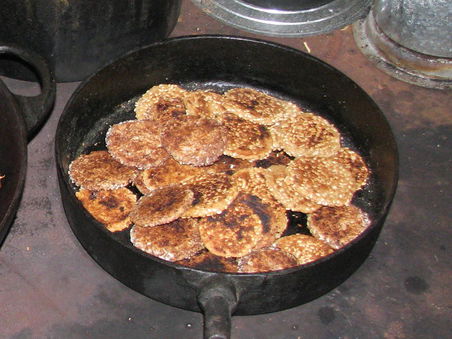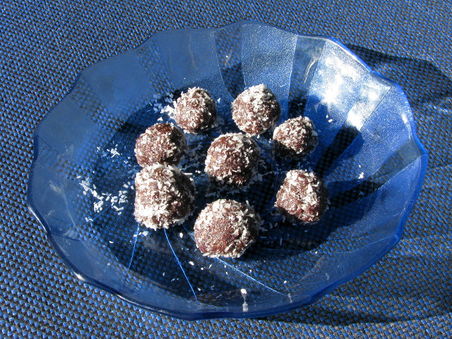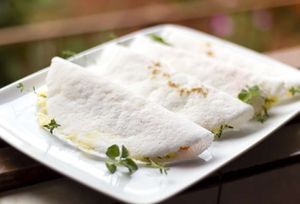Difference between revisions of "Meals on the land"
m |
(→Burger vegetariano) |
||
| (13 intermediate revisions by the same user not shown) | |||
| Line 1: | Line 1: | ||
| − | |||
After a year living on the land we've developed a fairly regular selection of meals that we have most of the time. Our [[vege patch]] is still not doing well enough to fully support us so we still buy most of our food in Canela every couple of months. We have a generally quite healthy diet that's almost vegan, we still buy some cheese from the neighbours every couple of weeks and a dozen eggs every month or two, but they're not an integral part of our regular diet. I've decided to describe our recipes in detail here because a few people have expressed interest in dropping meat and moving over to a similar diet to ours after trying it for a while and feeling healthier and loosing weight. | After a year living on the land we've developed a fairly regular selection of meals that we have most of the time. Our [[vege patch]] is still not doing well enough to fully support us so we still buy most of our food in Canela every couple of months. We have a generally quite healthy diet that's almost vegan, we still buy some cheese from the neighbours every couple of weeks and a dozen eggs every month or two, but they're not an integral part of our regular diet. I've decided to describe our recipes in detail here because a few people have expressed interest in dropping meat and moving over to a similar diet to ours after trying it for a while and feeling healthier and loosing weight. | ||
We didn't intend to make a diet for loosing weight at all, it has a lot of frying in oil but we found that the main culprits for gaining weight are meat and processed foods such as white sugar, white flower and white rice. We use only muskavado sugar and brown rice, but we do use some white flower but only in combination with wholemeal flower. Lightly frying vegetables in oil has the effect of making them more filling and satisfying which causes one to eat less, but the heavily processed foods have the opposite effect of causing one to never feel satisfied and feel like they need to eat more even when they're full. | We didn't intend to make a diet for loosing weight at all, it has a lot of frying in oil but we found that the main culprits for gaining weight are meat and processed foods such as white sugar, white flower and white rice. We use only muskavado sugar and brown rice, but we do use some white flower but only in combination with wholemeal flower. Lightly frying vegetables in oil has the effect of making them more filling and satisfying which causes one to eat less, but the heavily processed foods have the opposite effect of causing one to never feel satisfied and feel like they need to eat more even when they're full. | ||
| + | |||
| + | We recently discovered that our diet is very similar to the [http://www.hsph.harvard.edu/nutritionsource/pyramid-full-story/ The Healthy Eating Pyramid] which is the result of a study by the Harvard School of Public Health that rigorously analysed various diets and their results on health. This study harshly criticises the decades old food pyramid devised by the USDA (US Department of Agriculture) that has in turn been taught all over the western world and is based on a low fat, high carbohydrate diet. | ||
Another important aspect of the diet is to try and keep the body in an alkaline not acid state. Meat and processed foods make the body very acidic, and drugs like coffee, alcohol and cigarettes even more so. This is why we decided to only have coffee and alcohol rarely on special occasions. | Another important aspect of the diet is to try and keep the body in an alkaline not acid state. Meat and processed foods make the body very acidic, and drugs like coffee, alcohol and cigarettes even more so. This is why we decided to only have coffee and alcohol rarely on special occasions. | ||
| Line 8: | Line 9: | ||
== Bowlie == | == Bowlie == | ||
Every morning (until the fruit runs out) we have a "bowlie" for breakfast. This consists of a bowl of chopped fruit including banana, apple, papaya, mango and melon. Rolled oats and molasses are then added and mixed in. As the weeks go by after the shopping the range of fruit gets more and more sparse until the last few bowlies consist of only apple and melon and then after that it's down to "especialidade da casa" (see bottom of the page) for breakfast :-( | Every morning (until the fruit runs out) we have a "bowlie" for breakfast. This consists of a bowl of chopped fruit including banana, apple, papaya, mango and melon. Rolled oats and molasses are then added and mixed in. As the weeks go by after the shopping the range of fruit gets more and more sparse until the last few bowlies consist of only apple and melon and then after that it's down to "especialidade da casa" (see bottom of the page) for breakfast :-( | ||
| + | |||
| + | == Preserved vegetables == | ||
| + | Preserved vegetables are a must for off-griders! preserving means you can eat your vegetables all year round and not have to resort to supermarkets when they're out of season. | ||
| + | |||
| + | They're made with water and a bit of salt, vinegar, olive oil, sunflower oil, and some herbs such as garlic, basil, oregano, cumin seeds etc. This is based on [http://www.foodnetwork.com/recipes/jamie-oliver/amazing-pickled-and-marinated-vegetables-recipe/index.html this] Jamie Oliver recipe that Mum found. | ||
| + | |||
| + | The bottles and tops need to be submersed in boiling water for a few minutes to sterilise them, then after the mixture is added we like to stand the bottle in the boiling water again for a minute with the top on loosely and then take it out and tighten the top, this way as it cools the pressure inside reduces and forms a vacuum to seal the lid properly. | ||
| + | |||
| + | They should be left for at least two weeks for the herbs to soak in and flavour the vegetables. We've tested some after three months and they taste very good :-) | ||
| + | |||
| + | [[File:Preserved veges.jpg|300px]] | ||
== Salad == | == Salad == | ||
| − | We have a salad with most of our meals. We eat the salad first because this prepares the digestive system for the heavier food consumed afterwards. Our salads have as a base a variety of leafy greens such as spinach, kale, lettuce and cabbage most of which come from our [[vege patch]]. We then add a grated carrot and a grated beetroot and if we have any available some chopped tomato, capsicum and/or cucumber. For seasoning we then add balsamic vinegar and gersal (ground sesame seeds with salt) and sometimes olive oil. | + | We have a salad with most of our meals. We eat the salad first because this prepares the digestive system for the heavier food consumed afterwards. Our salads have as a base a variety of leafy greens such as spinach, kale, lettuce and cabbage most of which come from our [[vege patch]]. We then add a grated carrot and a grated beetroot and if we have any available some chopped tomato, capsicum and/or cucumber. For seasoning we then add balsamic vinegar and gersal (ground sesame seeds with salt) and sometimes olive oil. Here's a few versions of salads shown below, the first one is the most typical, the second one is main entirely from our own vegetables, and the last one has tabule in it as well which is especially good on flat bread :-) |
| − | + | {| | |
| − | [[File:Salad.jpg|300px]] | + | |[[File:Salad.jpg|300px]] |
| + | |[[File:Salad2.jpg|300px]] | ||
| + | |[[File:Tabule salad.jpg|300px]] | ||
| + | |} | ||
== Fried vegetables == | == Fried vegetables == | ||
| − | Usually the fried vegetables starts with frying chopped onions and/or garlic for about 5 minutes, I like to use the oil in which the sundried tomatos are preserved for frying these. Next we add a finely chopped leafy green which may be cabbage, spinach or kale and keep frying until they reduce down in size (sometimes we add sliced carrots and/or capsicum at this point too), and some canola oil may need to be added to help fry the greens. next brown rice or pasta is added and sometimes we'd add black beans at this point too ( | + | Usually the fried vegetables starts with frying chopped onions and/or garlic for about 5 minutes, I like to use the oil in which the sundried tomatos are preserved for frying these. Next we add a finely chopped leafy green which may be cabbage, spinach or kale and keep frying until they reduce down in size (sometimes we add sliced carrots and/or capsicum at this point too), and some canola oil may need to be added to help fry the greens. next brown rice or pasta is added and sometimes we'd add black beans at this point too (note that these have all been pre-cooked by boiling - we like to sun cook our rice if it's good weather to avoid wasting gas or wood). We add shoyu/tamari if it's rice as well as some more canola oil and sometimes a few drips of pimenta (oil in which chilli peppers have been preserving for many years) and some rock salt. We then let this fry for a good ten minutes stirring regularly. Finally we add some grated beetroot if available, some sesame oil and some parsley, marjoram or spring onion and keep frying for another 5 minutes. |
{| | {| | ||
| Line 23: | Line 38: | ||
== Flat bread & salad == | == Flat bread & salad == | ||
| + | Our flat bread is made with wholemeal flower and white flower (about 50% more wholemeal flower), canola oil, water and some rock salt. This is then divided into balls and each one rolled into a flat circle and cooked in the frying pan. After a few minutes it's turned over to cook the other side. A small bit of oil is added to the pan before cooking each side so that the bread can slide. I also like to press the bread flatter onto the pan to spread it out a bit more and maker it a bit thinner. | ||
{| | {| | ||
|[[File:Flat bread 1.jpg|300px]] | |[[File:Flat bread 1.jpg|300px]] | ||
|[[File:Flat bread 2.jpg|300px]] | |[[File:Flat bread 2.jpg|300px]] | ||
|} | |} | ||
| + | |||
| + | We usually eat the bread with salad on it in the format shown below. | ||
{| | {| | ||
|[[File:Flat bread & salad 1.jpg|300px]] | |[[File:Flat bread & salad 1.jpg|300px]] | ||
| Line 33: | Line 51: | ||
== Pizza Mexicana == | == Pizza Mexicana == | ||
| + | This was the closest thing we had to a pizza, it's corn flower fried in a pan with lots of oil to make a kind of "base" that vegetables and topping can be put on. We've stopped making it now though, because it's very difficult and also has too much oil in it. | ||
{| | {| | ||
|[[File:Pizza mexicana 1.jpg|300px]] | |[[File:Pizza mexicana 1.jpg|300px]] | ||
| Line 38: | Line 57: | ||
|} | |} | ||
| − | == | + | == Pizza Caipera == |
| + | Since we sometimes buy cheese from our neighbour Ziza, we can make real pizza! we make it with flat bread cooked on the open flame on the oven on one side, and then on the flame covered by the metal piece on the other side so it cooks slower allowing the topping to be added. | ||
| + | {| | ||
| + | |[[File:Pizza Caipera 2.jpg|300px]] | ||
| + | |[[File:Pizza Caipera 1.jpg|300px]] | ||
| + | |[[File:Pizza Caipera 3.jpg|300px]] | ||
| + | |} | ||
| + | |||
| + | == Burger vegetariano == | ||
| + | We make burger patties with lentils, farva beans, nuts and sesame seads. You add water to the mixture for 15 minutes and then fry them into patties. You can then make you're burger in the appropriate format :-) | ||
| + | {{table | ||
| + | |[[File:MicroBurger.jpg|300px]] | ||
| + | |[[File:MiniBurger1.jpg|300px]] | ||
| + | }} | ||
| + | |||
| + | == Pinhão == | ||
| + | {{:Pinhão}} | ||
| + | |||
| + | == Biscoitos Caipera == | ||
| + | These are what we have for a treat on the land. They're made similar to the flat bread with wholemeal flour, water and oil, but with more oil and also with Maskavado sugar added as well. Small balls of the doh are then rolled into balls and covered in sesame seeds or coconut and then pressed into a frying pan. It's best to just press them a little at first and more as they get harder from being cooked. They have to be flipped over often to avoid burning. We usually make chocolate ones that have cocoa added too, and cover the normal ones with sesame seeds and the chocolate ones with coconut. | ||
| + | |||
| + | [[File:Biscoitos Caipera.jpg|452px]] | ||
== Brigadeiro Caipera == | == Brigadeiro Caipera == | ||
| − | [[File:Brigadeiro caipera.jpg| | + | [[File:Brigadeiro caipera.jpg|452px]] |
== Especialidade da casa == | == Especialidade da casa == | ||
Especialidade da casa (specialty of the house) is a nice name to try and make us feel better about eating what is sometimes the only thing left when everything else has run out! it consists of crackers or flat bread with tahini spread on it topped with mollasses. It's quite healthy and keeps you going, but it's no longer something we look forward to after having to have nothing else for several days sometimes! | Especialidade da casa (specialty of the house) is a nice name to try and make us feel better about eating what is sometimes the only thing left when everything else has run out! it consists of crackers or flat bread with tahini spread on it topped with mollasses. It's quite healthy and keeps you going, but it's no longer something we look forward to after having to have nothing else for several days sometimes! | ||
| + | == Tapioca == | ||
| + | {{:Yocaholics!}} | ||
| + | <div style="clear:both"></div> | ||
== See also == | == See also == | ||
*[[Health]] | *[[Health]] | ||
| − | [[Category:Land]] | + | [[Category:Land]][[Category:Recipes]] |
Latest revision as of 14:14, 3 September 2017
After a year living on the land we've developed a fairly regular selection of meals that we have most of the time. Our vege patch is still not doing well enough to fully support us so we still buy most of our food in Canela every couple of months. We have a generally quite healthy diet that's almost vegan, we still buy some cheese from the neighbours every couple of weeks and a dozen eggs every month or two, but they're not an integral part of our regular diet. I've decided to describe our recipes in detail here because a few people have expressed interest in dropping meat and moving over to a similar diet to ours after trying it for a while and feeling healthier and loosing weight.
We didn't intend to make a diet for loosing weight at all, it has a lot of frying in oil but we found that the main culprits for gaining weight are meat and processed foods such as white sugar, white flower and white rice. We use only muskavado sugar and brown rice, but we do use some white flower but only in combination with wholemeal flower. Lightly frying vegetables in oil has the effect of making them more filling and satisfying which causes one to eat less, but the heavily processed foods have the opposite effect of causing one to never feel satisfied and feel like they need to eat more even when they're full.
We recently discovered that our diet is very similar to the The Healthy Eating Pyramid which is the result of a study by the Harvard School of Public Health that rigorously analysed various diets and their results on health. This study harshly criticises the decades old food pyramid devised by the USDA (US Department of Agriculture) that has in turn been taught all over the western world and is based on a low fat, high carbohydrate diet.
Another important aspect of the diet is to try and keep the body in an alkaline not acid state. Meat and processed foods make the body very acidic, and drugs like coffee, alcohol and cigarettes even more so. This is why we decided to only have coffee and alcohol rarely on special occasions.
Contents
Bowlie
Every morning (until the fruit runs out) we have a "bowlie" for breakfast. This consists of a bowl of chopped fruit including banana, apple, papaya, mango and melon. Rolled oats and molasses are then added and mixed in. As the weeks go by after the shopping the range of fruit gets more and more sparse until the last few bowlies consist of only apple and melon and then after that it's down to "especialidade da casa" (see bottom of the page) for breakfast :-(
Preserved vegetables
Preserved vegetables are a must for off-griders! preserving means you can eat your vegetables all year round and not have to resort to supermarkets when they're out of season.
They're made with water and a bit of salt, vinegar, olive oil, sunflower oil, and some herbs such as garlic, basil, oregano, cumin seeds etc. This is based on this Jamie Oliver recipe that Mum found.
The bottles and tops need to be submersed in boiling water for a few minutes to sterilise them, then after the mixture is added we like to stand the bottle in the boiling water again for a minute with the top on loosely and then take it out and tighten the top, this way as it cools the pressure inside reduces and forms a vacuum to seal the lid properly.
They should be left for at least two weeks for the herbs to soak in and flavour the vegetables. We've tested some after three months and they taste very good :-)
Salad
We have a salad with most of our meals. We eat the salad first because this prepares the digestive system for the heavier food consumed afterwards. Our salads have as a base a variety of leafy greens such as spinach, kale, lettuce and cabbage most of which come from our vege patch. We then add a grated carrot and a grated beetroot and if we have any available some chopped tomato, capsicum and/or cucumber. For seasoning we then add balsamic vinegar and gersal (ground sesame seeds with salt) and sometimes olive oil. Here's a few versions of salads shown below, the first one is the most typical, the second one is main entirely from our own vegetables, and the last one has tabule in it as well which is especially good on flat bread :-)
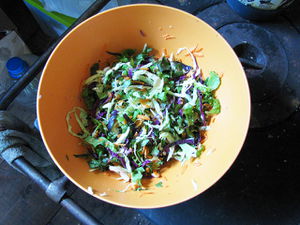
|
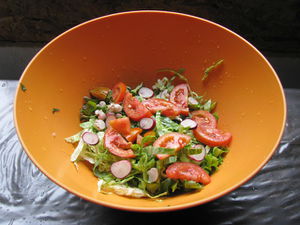
|
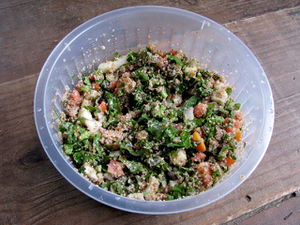
|
Fried vegetables
Usually the fried vegetables starts with frying chopped onions and/or garlic for about 5 minutes, I like to use the oil in which the sundried tomatos are preserved for frying these. Next we add a finely chopped leafy green which may be cabbage, spinach or kale and keep frying until they reduce down in size (sometimes we add sliced carrots and/or capsicum at this point too), and some canola oil may need to be added to help fry the greens. next brown rice or pasta is added and sometimes we'd add black beans at this point too (note that these have all been pre-cooked by boiling - we like to sun cook our rice if it's good weather to avoid wasting gas or wood). We add shoyu/tamari if it's rice as well as some more canola oil and sometimes a few drips of pimenta (oil in which chilli peppers have been preserving for many years) and some rock salt. We then let this fry for a good ten minutes stirring regularly. Finally we add some grated beetroot if available, some sesame oil and some parsley, marjoram or spring onion and keep frying for another 5 minutes.
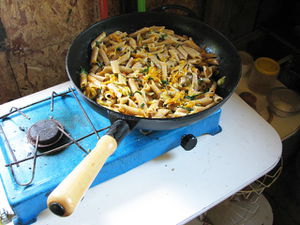
|
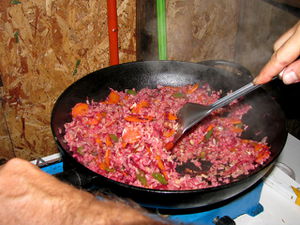
|
Flat bread & salad
Our flat bread is made with wholemeal flower and white flower (about 50% more wholemeal flower), canola oil, water and some rock salt. This is then divided into balls and each one rolled into a flat circle and cooked in the frying pan. After a few minutes it's turned over to cook the other side. A small bit of oil is added to the pan before cooking each side so that the bread can slide. I also like to press the bread flatter onto the pan to spread it out a bit more and maker it a bit thinner.
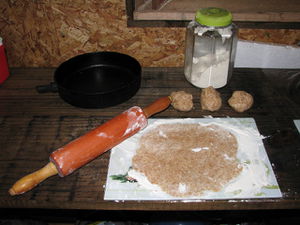
|
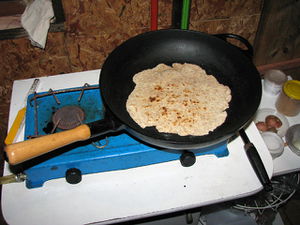
|
We usually eat the bread with salad on it in the format shown below.
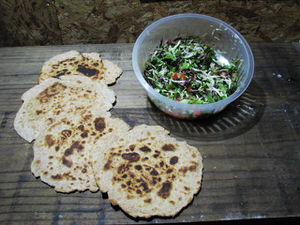
|
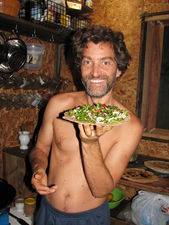
|
Pizza Mexicana
This was the closest thing we had to a pizza, it's corn flower fried in a pan with lots of oil to make a kind of "base" that vegetables and topping can be put on. We've stopped making it now though, because it's very difficult and also has too much oil in it.
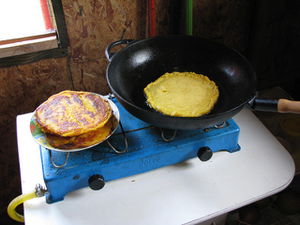
|
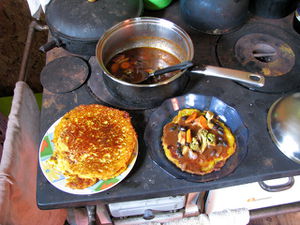
|
Pizza Caipera
Since we sometimes buy cheese from our neighbour Ziza, we can make real pizza! we make it with flat bread cooked on the open flame on the oven on one side, and then on the flame covered by the metal piece on the other side so it cooks slower allowing the topping to be added.
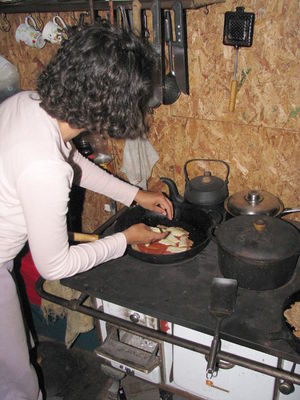
|
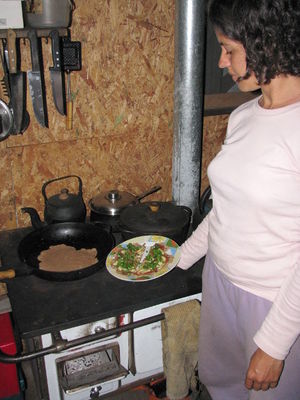
|
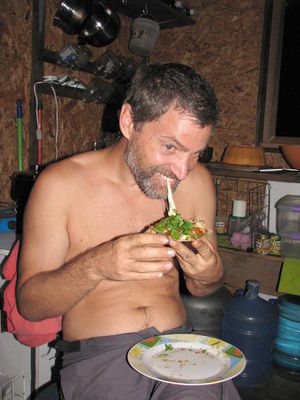
|
Burger vegetariano
We make burger patties with lentils, farva beans, nuts and sesame seads. You add water to the mixture for 15 minutes and then fry them into patties. You can then make you're burger in the appropriate format :-)
Pinhão
Pinhão are very abundant in May but start in April. We learned how to collect them from the trees when Candido, his wife Celia and some of their friends came to visit this month in 2013, but we prefer to just collect them from the ground as they're so abundant that there's more than enough for us without climbing the trees - or if you're a monkey you can eat them at the source :-)
After some coffee we all went into our small forest to collect Pinhão from the Araucária trees which are very common around here. The Pinhão nut is very similar to a Chestnut in texture and flavour. The way to get them is to climb up the tree with a long stick and prod all the fruits that are ready so that they break open and all the nuts (often a hundred in each fruit) pour to the ground. The trees are very tall and have no branches for the first ten metres or so and the trunks are too wide to reach around, so the climber uses a rope and special boots to climb the tree as shown below.
The nuts come packaged in a large spherical fruit which contains sixty to a hundred Pinhão. When the fruits are ripe they fall to the ground and shatter scattering the Pinhão around the base of the tree. Also we found that most of the fallen ones are actually due to monkeys breaking them to eat the Pinhão rather than them having naturally fallen.

|
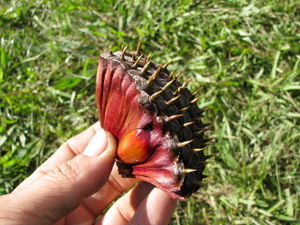
|
They can be boiled to be chopped up and used in various dishes like pesto or soup. Also a simple way to cook them is to put many into a large frying pan directly over the flames and keep moving them so all their sides get cooked. When they're quite black they can be opened very easily and eaten straight away. They're very similar to pine nuts, in fact many people don't know the difference, for example the English wikipedia article for pine nut links to the Pinhão article in the Portguese Wikipedia. The normal pine nut is called "Pinha" which comes from a pine tree (Pinheiro), and "hão" on the end of words means "big", so Pinhãos are big pine nuts :)
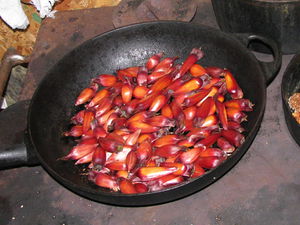
|
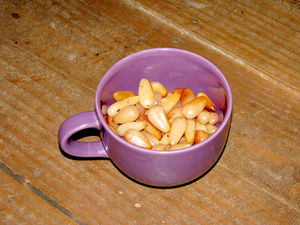
|
But my favourite method of cooking them was introduced by our local friend Eduardo and is called Sapeco. This method is really nice because it's about cooking the Pinhão with the tree's own fallen leaves ("Grinfa") and nothing more. You stack the Grinfa up in a big pile with an indentation in the top to pour the Pinhão into.
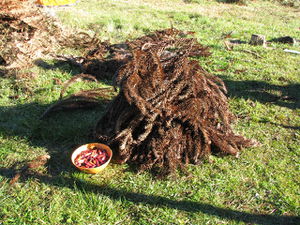 |
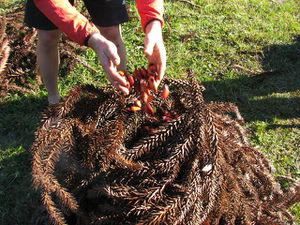 |
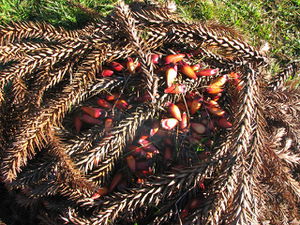 |
The Grinfa are extremely easy to light, even when they have moisture on them you can get them going with a lighter or match with no need for anything else like paper. It's best to light it at three or four locations around the base so it burns evenly. Once it gets going it's like a volcano with really thick smoke and gets really hot. After a few minutes it's all burned and collapsed down, and you then scrape the cooked Pinhão out of all the ashes to eat them. Here's some pictures of us having them for breakfast with Chimarrão :-)
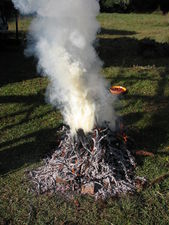 |
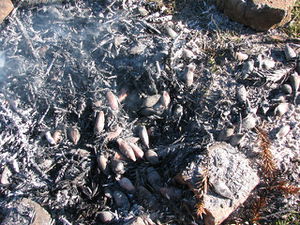 |
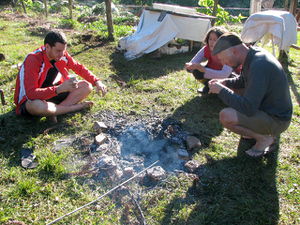 |
Biscoitos Caipera
These are what we have for a treat on the land. They're made similar to the flat bread with wholemeal flour, water and oil, but with more oil and also with Maskavado sugar added as well. Small balls of the doh are then rolled into balls and covered in sesame seeds or coconut and then pressed into a frying pan. It's best to just press them a little at first and more as they get harder from being cooked. They have to be flipped over often to avoid burning. We usually make chocolate ones that have cocoa added too, and cover the normal ones with sesame seeds and the chocolate ones with coconut.
Brigadeiro Caipera
Especialidade da casa
Especialidade da casa (specialty of the house) is a nice name to try and make us feel better about eating what is sometimes the only thing left when everything else has run out! it consists of crackers or flat bread with tahini spread on it topped with mollasses. It's quite healthy and keeps you going, but it's no longer something we look forward to after having to have nothing else for several days sometimes!
Tapioca
When we were at Arca Verde we noticed that they were making Tapioca a different way than us, they used a more course sieve and made them really thick. We asked them how they did it because ours don't work if we try to make them thick, we have to make them thin and they're really difficult to get the water content exactly right so they don't break.
It turns turns out there's two different types of Manioc starch, sweet and sour. We've been using sweet, but they use sour, and that makes all the difference. The sour has a sort of cheesie smell when it's raw, but they both taste pretty much the same after you cook them. But the sour starch is a very different consistency and is much easier to work with.
So now we're having Tapioca as part of our meals almost every day instead of bread since it's so easy! And we also add some corn flour too to make it a bit more nutritious :-)
